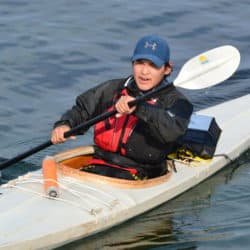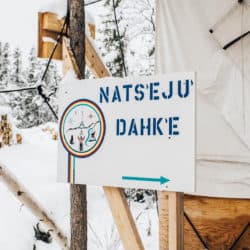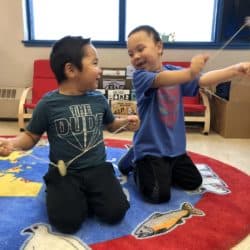Every year, AIP laureates receive original artwork. The piece pictured at right – Once the Darkness Is Realized by Blake Lepine, an artist from Carcross Tagish First Nation in the Yukon – is one of the pieces from 2019.
***
A polar vortex settles over the Northwest Territories (NWT), and by one o’clock in the afternoon, the mercury dips to minus 50 degrees Celsius. Glen Abernethy, former MLA for the Great Slave riding and current NWT region manager for the Arctic Inspiration Prize (AIP), worries about his connection. “I’m at a cabin 35 kilometres outside of Yellowknife,” he explains, voice crackling, “and the wind is blowing in the wrong direction.”
As the line cuts out, it’s not hard to imagine epic scenes of “The North”: glittery plains of snow, polar bears ambling across the ice, the pulsating aurora borealis. But the North is “so much more than polar bears and seals,” writes Sheila Watt-Cloutier, Inuit activist and former international chair for the Inuit Circumpolar Council, in The Right to Be Cold. Rather than a “frozen wasteland,” she says, the North teems with life, rich culture, traditional wisdom. It’s inhabited by a population positioned at the “front lines” of some of the most urgent issues of our time, poised to create a “powerful bridge between North and South, between western scientists, biologists and conservationists and Aboriginal traditional knowledge.”
Initiatives such as the AIP form part of that bridge, providing “southern philanthropy” with access to a network of communities spread across Canada’s North and a chance to support, and learn from, innovative local projects that are “pursuing real change in real time,” Abernethy says. The AIP’s partnerships, ranging from the Nunavut Arts and Crafts Association to Oxfam Canada to the Aboriginal Peoples Television Network (APTN), reflect a broad-based approach to engaging stakeholders. Its nearly 300 ambassadors represent organizations ranging from the Institute for Circumpolar Health Research to the Mining Association of Canada to Kwanlin Dün First Nation. Winning projects span from teaching Inuit traditional law to creating food security to empowering youth by teaching them how to code.
But joining the mission of the AIP comes with one condition: leave your southern footwear behind, Abernethy says. “We wear big white boots up here.” Such boots, designed purely for warmth, are more than a wardrobe staple – they embody the AIP’s boots-on-the-ground approach, where locals know best “because nobody knows their needs better than themselves,” says Abernethy. Hence the AIP’s motto: for the North, by the North, with unconditional support from the south. While southern support is very welcome, he explains, “we can’t afford to have people come in with ideas of what the North is and say, ‘Yes, you can have our money, but you’re going to have to change your project.’”
When one looks at a map of Canada, the North isn’t so easy to define. “Where does ‘north’ begin, and what is it like?” asks the Government of Yukon’s Dempster Highway Travelogue, guiding the adventurous along a 737-kilometre journey from Dawson City to Inuvik, “where north is a way of life, not just an arrow.” For some, just reaching Dawson City, 3,000 kilometres straight north of Vancouver, might feel north enough. But “north” is as much about perception as geography. Paul Gruner, CEO of the award-winning Det’on Cho Management and member of the AIP selection committee (and a member of The Philanthropist’s editorial advisory committee), notes that for some people living above the Arctic Circle, Dawson City may as well be Florida. The vastness of the North, an area that comprises 40% of Canada’s territory, “is often misunderstood,” he adds. “It’s a bit of a mystery for people.”
Abernethy, who was born and bred in the NWT, has visited every one of the territories’ 33 communities, which range in size from 50 people in a fly-in community to about 21,000 in the capital city of Yellowknife. He describes a world largely dependent on ice roads and barges, where temperature extremes and months of perpetual daylight or perpetual darkness reign. “People in the south don’t always understand the realities of the climate and nature in which we live,” Abernethy says. But it’s precisely this climate and nature that produces a people who are incredibly hardy, smart, and, as he notes, “creative as creative can be.”
Gruner agrees, attributing to Northerners a unique intelligence, in both a traditional and non-traditional sense. “We’re also very much best-in-class in some ways,” he says, citing examples of successful Indigenous-led corporations, settled land claims, and self-governing First Nations.
The foundations of the AIP rest on the laurels of such achievements. People from southern Canada might not always understand how this different landscape of power dynamics works, says Abernethy. Compared to the rest of the country, where First Nations reserve systems are often the norm, the North “is a different beast.”
According to Indigenous and Northern Affairs Canada, there are 25 self-government agreements in Canada involving 43 Indigenous communities, most of them in Canada’s North – home to more than 100,000 First Nations, Métis, and Inuit people (over half the population). Nine Indigenous languages are recognized as official languages in the NWT, including Inuktitut, Chipewyan, and Gwich’in. Eleven of the Yukon’s 14 First Nations are self-governing. The Nunavut Agreement, signed in 1993, created “a globally recognized jurisdiction,” according to the premier of Nunavut, whose “culture, innovations, traditions and values continue to intrigue and impact people around the world.”
While the struggles faced by some of these communities, such as suicide rates nine times higher for Inuit than non-Indigenous Canadians, often make the news, the AIP recognizes the deeper issues beneath the headlines. Encouraging applicants to create their own solutions to their own problems acknowledges how outside interference has left scars. Abernethy recalls how, as a government official, he visited a small Indigenous community where a 75-year-old Elder came up to him and said, “I wish they’d stop studying us.” Although the Elder was referring to the constant stream of researchers drawn to the North, “there are definite parallels with philanthropy,” Abernethy says.
Numerous reports document a history of contact with government officials and researchers who didn’t always have the best interests of local populations at heart, to put it mildly. Examples of government-initiated atrocities abound, especially for Inuit, including the slaughter of sled dogs and a forced “relocation” to the High Arctic. According to the report Lessons Learned through Research Partnership and Capacity Enhancement in Inuit Nunangat, researchers had a habit of treating locals “as objects of study or bystanders.” Used as a “tool for colonialism,” they write, such research is “rife with historic examples of racism and exploitation.” Unfortunately, the authors note, this practice has spilled over into “current approaches to research, governance, funding, policies, and practices.”
AIP co-founder Arnold Witzig, whose love for the North was so strong that he and his partner, Simi Sharifi, transferred the bulk of their Vancouver-based foundation to the prize, sees the AIP as a vehicle to remedy such injustices. After spending decades listening to the stories of “countless” Indigenous Northerners, Witzig understands that reconciliation is more than just a word to them. While northern governments and organizations have shifted attitudes, their southern counterparts need to catch up. They “still don’t seem to understand the true, urgent, and massive need to now, and in the future, truly act on reconciliation,” he says. “It is time for the non-Indigenous south to take reconciliation seriously. It is actually time for ‘reconcili-action.’”
Witzig invites the philanthropic community to see the AIP as an opportunity to heed the Calls to Action outlined in the Truth and Reconciliation Commission report. Nearly 100 Canadian organizations have signed the Philanthropic Community’s Declaration of Action thus far, signalling their collective intention of “using their philanthropic resources in service to Reconciliation.” In an Association of Fundraising Professionals (AFP) report – Philanthropic Sector & Truth and Reconciliation – Sharon Redsky, an AFP Inclusive Giving Fellow, notes the sector’s readiness to move away “from power imbalances to equitable partnerships.” Opportunities abound for southern philanthropy to explore this via the AIP, says Witzig. Helping to ensure that winning projects can sustain themselves, for example, would create a huge impact. While the AIP works as a catalyst for winning projects by providing “initial risk capital,” he says, long-term sustainability remains a challenge.
Million-dollar prizewinners such as Fostering Open eXpression Among Youth (FOXY) – “a revolutionary program for young women and gender diverse youth that promotes mental and sexual health and healthy relationships across the North” – continue to work hard to achieve sustainability. Candice Lys, FOXY co-founder and executive director, describes their 2014 win as a “game-changer.” In the past six years, FOXY has reached more than 6,000 youth throughout the NWT, Nunavut, and the Yukon. “Youth tell us they have a greater connection to themselves,” she says, and feel “more connected to their communities and see themselves as leaders in their communities.” An upcoming AIP impact report notes that a $3-million investment in FOXY has generated an impact of approximately $15 million in the northern communities it’s served.
While FOXY is lucky enough to have a funding partner for the next couple of years, Lys says the organization would benefit from more unrestricted and core-needs funding. “Everybody wants to fund the sexy parts of non-profit organizations . . . that look really good on paper,” she says. But FOXY also has to worry about keeping the lights on and offering competitive wages to attract and retain the high-quality staff necessary to ensure such high-quality programming.
“A million dollars is awesome,” she says, “but it’s what happens after the million that I think the AIP is still trying to figure out.”
This is exactly where southern philanthropy could step in, Witzig says. Funders could reach out to make connections with project winners, which the AIP calls laureates, who often lack connections or knowledge about the philanthropic sector. They could also work with The Circle on Philanthropy and Aboriginal Peoples in Canada, of which the AIP is an Indigenous member.
Witzig believes that working together lies at the heart of the AIP’s continuing success, and that, ultimately, the success of the entire country depends on the success of the North. “Nobody can do everything on their own – not the Northerners, not the southerners, not the AIP,” he says. A recent move by the NWT to become the second jurisdiction in Canada to adopt the 13-year-old United Nations Declaration on the Rights of Indigenous Peoples (UNDRIP) signals a stronger commitment to widen the circle. “It sends a strong message that no one government can go it alone,” Dene National Chief Norman Yakeleya told Cabin Radio, in Yellowknife. “Recognition of UNDRIP would give assurance that we are on the right track – we’re going to work together.”
The vision formulated last year by AIP trustees is based on the idea that collaboration creates “a stronger Canada,” Witzig says. “A stronger country through the experience and the values of the North. Imagine what that means and how this is different from the perception we have in the south of the North?”
What that means is on the minds of more and more people as the North takes the spotlight, on both a national and international stage. As ice caps melt at an alarming rate, and the world remains gripped by a deadly pandemic, some are looking north for guidance about how to survive “the new normal.” A BBC News series, The New Arctic, calls the region “our eyes and ears” for navigating a changing planet. A recent article in The Guardian – “Cold Comfort: What Can Arctic Cultures Teach Us for Our Future Survival?” – explores a pan-Arctic story of “remarkable resilience,” spanning a millennia. The author notes the irony that those in “the south,” who for centuries tried to suppress the cultures of the North, “might now have to go cap-in-hand and ask: what is the secret of long human endurance? How are we to live in extreme climates? How to weather calamity?”
While it’s probably wiser to wear one’s cap (and big white boots) when it’s minus 50 outside, Canada’s North has been preparing for this moment. In the nine years since the AIP was founded, Gruner, Witzig, and Abernethy have noticed dramatic change in the northern landscape. Gruner describes a more sophisticated way of doing business, an increased drive to succeed, and a trend of people returning home to work instead of migrating south. Recent statistics attest to this. The NWT Bureau of Statistics just reported the lowest unemployment rates in the country, and the population of the Yukon has grown by 21% in the last decade.
Witzig notes that the ubiquitous Toronto guy with a briefcase, once a fixture at northern board meetings (“because that’s what people thought was needed,” he says) now stays at home – and not because of COVID. Even Witzig plans to stay home in the very near future, he says, and will “hand over the reins” of the AIP to the Northerners, beginning the process “of disappearing into history.”
As the polar vortex winds continue to blow, Abernethy is warmed by being a part of something he sees the positive impacts of every day. From a man who lived on the streets of Yellowknife for 25 years becoming sober at an Indigenous wellness camp, to young girls finding “internal confidence” through FOXY, the snowball effect of the AIP grows stronger, he says, especially among youth. “They’ve moved from asking ‘Why can’t we do this?’ to ‘Let’s get this done.’” To keep the momentum going depends on the rest of us, he says. The AIP invitation to become part of the solution is an invitation to enter the future of a new North – whose biggest mystery may be why it has taken the south so long to discover the value of its treasures. “You’ve got to come here,” he says. “You’ve got to see it.”


